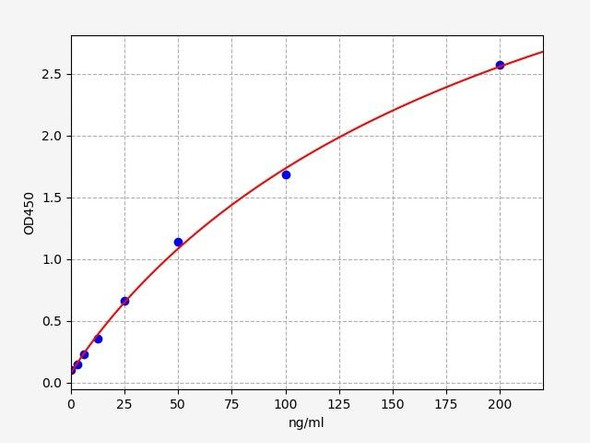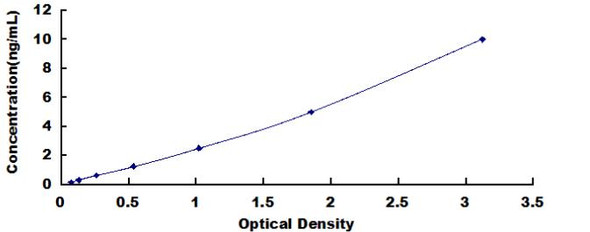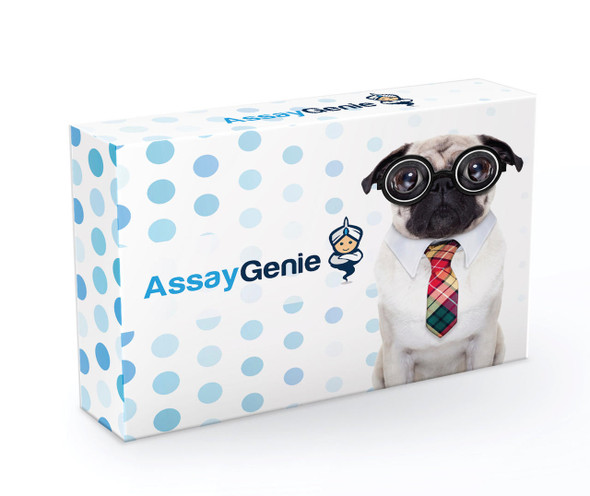Human Lysosomal alpha-glucosidase (GAA) ELISA Kit (HUEB0458)
- SKU:
- HUEB0458
- Product Type:
- ELISA Kit
- Size:
- 96 Assays
- Uniprot:
- P10253
- Range:
- 3.12-200 ng/mL
- ELISA Type:
- Sandwich
- Synonyms:
- GAA, Lysosomal alpha-Glucosidase, Acid alpha-Glucosidase, Acid Maltase, LYAG, Acid maltase, Aglucosidase alfa
- Reactivity:
- Human
Description
Human Lysosomal alpha-glucosidase (GAA) ELISA Kit
The Human Lysosomal Alpha-Glucosidase (GAA) ELISA Kit is specifically designed for the accurate quantification of GAA levels in human samples. This kit offers high sensitivity and specificity, ensuring precise and reproducible results for various research applications.Lysosomal Alpha-Glucosidase is a key enzyme involved in breaking down glycogen in lysosomes, a cellular organelle responsible for waste disposal. Deficiencies in GAA activity can lead to glycogen accumulation, causing serious diseases such as Pompe disease.
The measurement of GAA levels is crucial for understanding disease progression, monitoring treatment effectiveness, and developing novel therapies.With its reliable performance and ease of use, the Human Lysosomal Alpha-Glucosidase ELISA Kit is an indispensable tool for researchers studying lysosomal storage disorders and exploring potential treatments for these debilitating conditions.
| Product Name: | Human Lysosomal alpha-glucosidase (GAA) ELISA Kit |
| SKU: | HUEB0458 |
| Size: | 96T |
| Target: | Human Lysosomal alpha-glucosidase (GAA) |
| Synonyms: | Acid maltase, Aglucosidase alfa |
| Assay Type: | Sandwich |
| Detection Method: | ELISA |
| Reactivity: | Human |
| Detection Range: | 3.12-200ng/mL |
| Sensitivity: | 0.98ng/mL |
| Intra CV: | 4.3% | ||||||||||||||||||||
| Inter CV: | 7.5% | ||||||||||||||||||||
| Linearity: |
| ||||||||||||||||||||
| Recovery: |
| ||||||||||||||||||||
| Function: | Essential for the degradation of glygogen to glucose in lysosomes. |
| Uniprot: | P10253 |
| Sample Type: | Serum, plasma, tissue homogenates, cell culture supernates and other biological fluids |
| Specificity: | Natural and recombinant human Lysosomal alpha-glucosidase |
| Research Area: | Metabolism |
| Subcellular Location: | Lysosome Lysosome membrane |
| Storage: | Please see kit components below for exact storage details |
| Note: | For research use only |
| UniProt Protein Function: | GAA: Essential for the degradation of glygogen to glucose in lysosomes. Defects in GAA are the cause of glycogen storage disease type 2 (GSD2); also called acid alpha-glucosidase (GAA) deficiency or acid maltase deficiency (AMD). GSD2 is a metabolic disorder with a broad clinical spectrum. The severe infantile form, or Pompe disease, presents at birth with massive accumulation of glycogen in muscle, heart and liver. Cardiomyopathy and muscular hypotonia are the cardinal features of this form whose life expectancy is less than two years. The juvenile and adult forms present as limb-girdle muscular dystrophy beginning in the lower limbs. Final outcome depends on respiratory muscle failure. Patients with the adult form can be free of clinical symptoms for most of their life but finally develop a slowly progressive myopathy. Belongs to the glycosyl hydrolase 31 family. |
| UniProt Protein Details: | Protein type:Contractile; Carbohydrate Metabolism - starch and sucrose; Hydrolase; EC 3.2.1.20; Carbohydrate Metabolism - galactose Chromosomal Location of Human Ortholog: 17q25.2-q25.3 Cellular Component: lysosomal lumen; lysosomal membrane; lysosome; membrane Molecular Function:alpha-glucosidase activity; oligo-1,6-glucosidase activity Biological Process: cardiac muscle contraction; diaphragm contraction; glucose metabolic process; glycogen catabolic process; lysosome organization and biogenesis; maltose metabolic process; sucrose metabolic process; vacuolar sequestering Disease: Glycogen Storage Disease Ii |
| NCBI Summary: | This gene encodes lysosomal alpha-glucosidase, which is essential for the degradation of glycogen to glucose in lysosomes. The encoded preproprotein is proteolytically processed to generate multiple intermediate forms and the mature form of the enzyme. Defects in this gene are the cause of glycogen storage disease II, also known as Pompe's disease, which is an autosomal recessive disorder with a broad clinical spectrum. Alternative splicing results in multiple transcript variants. [provided by RefSeq, Jan 2016] |
| UniProt Code: | P10253 |
| NCBI GenInfo Identifier: | 317373572 |
| NCBI Gene ID: | 2548 |
| NCBI Accession: | P10253.4 |
| UniProt Secondary Accession: | P10253,Q09GN4, Q14351, Q16302, Q8IWE7, |
| UniProt Related Accession: | P10253 |
| Molecular Weight: | 105,324 Da |
| NCBI Full Name: | Lysosomal alpha-glucosidase |
| NCBI Synonym Full Names: | glucosidase alpha, acid |
| NCBI Official Symbol: | GAA |
| NCBI Official Synonym Symbols: | LYAG |
| NCBI Protein Information: | lysosomal alpha-glucosidase |
| UniProt Protein Name: | Lysosomal alpha-glucosidase |
| UniProt Synonym Protein Names: | Acid maltase; Aglucosidase alfa |
| Protein Family: | Lysosomal alpha-glucosidase |
| UniProt Gene Name: | GAA |
| UniProt Entry Name: | LYAG_HUMAN |
| Component | Quantity (96 Assays) | Storage |
| ELISA Microplate (Dismountable) | 8×12 strips | -20°C |
| Lyophilized Standard | 2 | -20°C |
| Sample Diluent | 20ml | -20°C |
| Assay Diluent A | 10mL | -20°C |
| Assay Diluent B | 10mL | -20°C |
| Detection Reagent A | 120µL | -20°C |
| Detection Reagent B | 120µL | -20°C |
| Wash Buffer | 30mL | 4°C |
| Substrate | 10mL | 4°C |
| Stop Solution | 10mL | 4°C |
| Plate Sealer | 5 | - |
Other materials and equipment required:
- Microplate reader with 450 nm wavelength filter
- Multichannel Pipette, Pipette, microcentrifuge tubes and disposable pipette tips
- Incubator
- Deionized or distilled water
- Absorbent paper
- Buffer resevoir
*Note: The below protocol is a sample protocol. Protocols are specific to each batch/lot. For the correct instructions please follow the protocol included in your kit.
Allow all reagents to reach room temperature (Please do not dissolve the reagents at 37°C directly). All the reagents should be mixed thoroughly by gently swirling before pipetting. Avoid foaming. Keep appropriate numbers of strips for 1 experiment and remove extra strips from microtiter plate. Removed strips should be resealed and stored at -20°C until the kits expiry date. Prepare all reagents, working standards and samples as directed in the previous sections. Please predict the concentration before assaying. If values for these are not within the range of the standard curve, users must determine the optimal sample dilutions for their experiments. We recommend running all samples in duplicate.
| Step | |
| 1. | Add Sample: Add 100µL of Standard, Blank, or Sample per well. The blank well is added with Sample diluent. Solutions are added to the bottom of micro ELISA plate well, avoid inside wall touching and foaming as possible. Mix it gently. Cover the plate with sealer we provided. Incubate for 120 minutes at 37°C. |
| 2. | Remove the liquid from each well, don't wash. Add 100µL of Detection Reagent A working solution to each well. Cover with the Plate sealer. Gently tap the plate to ensure thorough mixing. Incubate for 1 hour at 37°C. Note: if Detection Reagent A appears cloudy warm to room temperature until solution is uniform. |
| 3. | Aspirate each well and wash, repeating the process three times. Wash by filling each well with Wash Buffer (approximately 400µL) (a squirt bottle, multi-channel pipette,manifold dispenser or automated washer are needed). Complete removal of liquid at each step is essential. After the last wash, completely remove remaining Wash Buffer by aspirating or decanting. Invert the plate and pat it against thick clean absorbent paper. |
| 4. | Add 100µL of Detection Reagent B working solution to each well. Cover with the Plate sealer. Incubate for 60 minutes at 37°C. |
| 5. | Repeat the wash process for five times as conducted in step 3. |
| 6. | Add 90µL of Substrate Solution to each well. Cover with a new Plate sealer and incubate for 10-20 minutes at 37°C. Protect the plate from light. The reaction time can be shortened or extended according to the actual color change, but this should not exceed more than 30 minutes. When apparent gradient appears in standard wells, user should terminatethe reaction. |
| 7. | Add 50µL of Stop Solution to each well. If color change does not appear uniform, gently tap the plate to ensure thorough mixing. |
| 8. | Determine the optical density (OD value) of each well at once, using a micro-plate reader set to 450 nm. User should open the micro-plate reader in advance, preheat the instrument, and set the testing parameters. |
| 9. | After experiment, store all reagents according to the specified storage temperature respectively until their expiry. |
When carrying out an ELISA assay it is important to prepare your samples in order to achieve the best possible results. Below we have a list of procedures for the preparation of samples for different sample types.
| Sample Type | Protocol |
| Serum | If using serum separator tubes, allow samples to clot for 30 minutes at room temperature. Centrifuge for 10 minutes at 1,000x g. Collect the serum fraction and assay promptly or aliquot and store the samples at -80°C. Avoid multiple freeze-thaw cycles. If serum separator tubes are not being used, allow samples to clot overnight at 2-8°C. Centrifuge for 10 minutes at 1,000x g. Remove serum and assay promptly or aliquot and store the samples at -80°C. Avoid multiple freeze-thaw cycles. |
| Plasma | Collect plasma using EDTA or heparin as an anticoagulant. Centrifuge samples at 4°C for 15 mins at 1000 × g within 30 mins of collection. Collect the plasma fraction and assay promptly or aliquot and store the samples at -80°C. Avoid multiple freeze-thaw cycles. Note: Over haemolysed samples are not suitable for use with this kit. |
| Urine & Cerebrospinal Fluid | Collect the urine (mid-stream) in a sterile container, centrifuge for 20 mins at 2000-3000 rpm. Remove supernatant and assay immediately. If any precipitation is detected, repeat the centrifugation step. A similar protocol can be used for cerebrospinal fluid. |
| Cell culture supernatant | Collect the cell culture media by pipette, followed by centrifugation at 4°C for 20 mins at 1500 rpm. Collect the clear supernatant and assay immediately. |
| Cell lysates | Solubilize cells in lysis buffer and allow to sit on ice for 30 minutes. Centrifuge tubes at 14,000 x g for 5 minutes to remove insoluble material. Aliquot the supernatant into a new tube and discard the remaining whole cell extract. Quantify total protein concentration using a total protein assay. Assay immediately or aliquot and store at ≤ -20 °C. |
| Tissue homogenates | The preparation of tissue homogenates will vary depending upon tissue type. Rinse tissue with 1X PBS to remove excess blood & homogenize in 20ml of 1X PBS (including protease inhibitors) and store overnight at ≤ -20°C. Two freeze-thaw cycles are required to break the cell membranes. To further disrupt the cell membranes you can sonicate the samples. Centrifuge homogenates for 5 mins at 5000xg. Remove the supernatant and assay immediately or aliquot and store at -20°C or -80°C. |
| Tissue lysates | Rinse tissue with PBS, cut into 1-2 mm pieces, and homogenize with a tissue homogenizer in PBS. Add an equal volume of RIPA buffer containing protease inhibitors and lyse tissues at room temperature for 30 minutes with gentle agitation. Centrifuge to remove debris. Quantify total protein concentration using a total protein assay. Assay immediately or aliquot and store at ≤ -20 °C. |
| Breast Milk | Collect milk samples and centrifuge at 10,000 x g for 60 min at 4°C. Aliquot the supernatant and assay. For long term use, store samples at -80°C. Minimize freeze/thaw cycles. |









